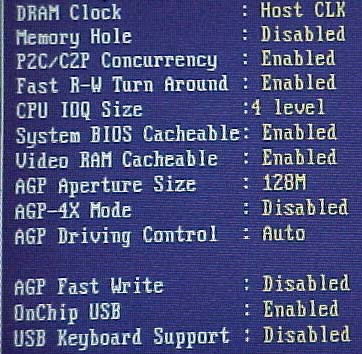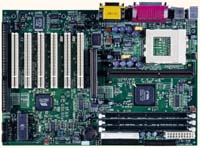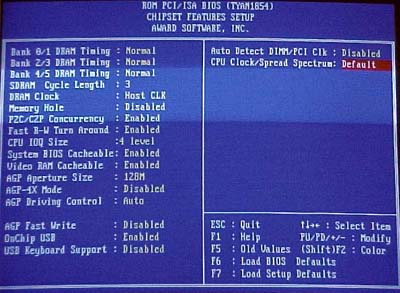
Original Link: https://www.anandtech.com/show/441
Tyan S1854 Trinity 400 VIA Apollo Pro 133A Slot-1/Socket-370 ATX
by Mike Andrawes on January 11, 2000 6:16 PM EST- Posted in
- Motherboards
Tyan has been producing top notch, high performance server/workstation motherboards for over 10 years. Although they've had a few hiccups along the way, they've been able to transition to the higher volume consumer space in recent years. For the most part, their server roots have shown in their consumer level boards, which were rock solid as far as stability goes and very rich in features.
For the most part, Tyan's success was built upon boards based on Intel chipsets. With the advent of the Super7 platform, they were forced to branch out and use VIA chipsets if they wanted to support Super7. Some of Tyan's early VIA based efforts were less than stellar, but the S1598 Trinity MVP3 restored our confidence in such boards.
With the launch of the "Coppermine" Pentium IIIE and its subsequent official support for the 133 MHz bus, an interesting situation arose for VIA and Intel in the chipset market. Intel's solution, the i820 was delayed by a few months do to stability issues. Throw in the fact that RAMBUS currently costs almost five times what SDRAM costs, and VIA's Apollo Pro 133A chipset begins to look very appealing. Tyan decided to go with the Apollo Pro 133A and teamed up with Micron to have one of the first 133 MHz FSB solutions in the market with the latest iteration of the Millennia Max. The motherboard in that award winning system - the Tyan S1854 Trinity 400.
New Anand Tech Report Card Rating 88/B+
| CPU Interface | Slot-1/Socket 370 |
| Chipset | VIA Apollo Pro 133A (VIA 694X / VIA 596B) |
| L2 Cache | N/A (on-chip) |
| Form Factor | ATX |
| Bus Speeds | 66
/ 75 / 83 / 95 100 / 112 / 117 / 124 133 / 138 / 140 / 150 |
| Clock Multipliers | 2.0x - 8.0x |
| Voltages Supported | Auto Detect |
| Memory Slots | 3 168-pin DIMM Slots |
| Expansion Slots | 0 AMR Slots 1 AGP Slot 6 PCI Slots (5 Full Length) 1 (optional) ISA Slot (1 Shared / 1 Full Length) |
| BIOS | Award 4.51PG |
The Good
At first, the Trinity 400 looks like a very odd board, with both Slot-1 and Socket-370 interfaces on board. While we've seen this before in the AnandTech lab, it's usually been reserved to boards from manufacturers much smaller than Tyan. However, the Trinity 400 is loosely based on Tyan's older Trinity 371, a similar Slot-1/Socket-370 design that used either the Intel i440BX or the VIA Apollo Pro Plus chipset.
The use of two different CPU interfaces creates for an interesting layout of the PCB. You might think it would create an extremely large PCB, but in fact it doesn't, as the Trinity 400 is just a bit longer than most ATX motherboards. Everything is laid out as it should be, with the HDD, FDD, and ATX power connectors all right at the front of the board, helping to reduce cable clutter inside crowded systems.
The Slot-1 connector sits flush with the VIA 694X North Bridge, while the Socket-370 is located immediately behind the Slot-1 connector. Next to both CPU interfaces, there is the VRM 8.4 compatible voltage regulator, which features nine 1000uF capacitors in this implementation. Despite being rated to run at 133 MHz, with the option of overclocking it to 150 MHz, the 694X chip was not covered with a heatsink. Fortunately, we did not notice any heat related issues in our evaluation sample.
The Trinity 400's flexibility continues with an available 6/1/1 (PCI/ISA/AGP) expansion slot configuration. The sole ISA slot is full length, however, while "only" 5 of the 6 PCI slots can boast such a feature. That single ISA slot is actually optional, reflecting the fact that ISA is definitely on its way out despite a few hold outs. Creative Labs ES1373 PCI audio is also optionally integrated on the motherboard, although this option has not been released to distributors as of yet. The Creative Labs sound is a basic PCI audio solution that offers few advanced features, such as 3D audio, but otherwise gets the job done quite well.
It's should be noted that the Trinity 400 is PCI 2.2 compliant, meaning that 3.3v standby power is required for all PCI slots, DIMM banks, and PS/2 outputs, so be sure to unplug the AC power cord before adding or removing any peripherals. This is one of those times that a physical power switch on the power supply can come in handy.
Three DIMM slots are sandwiched right up next to the VIA 694X North Bridge and provide support for up to 768MB of SDRAM. The proximity of those DIMM slots may prevent the use of some larger heatsinks on a Slot-1 CPU. Thanks to the Apollo Pro 133A's flexible memory configuration, you can use your old PC100 SDRAM with a newer 133 MHz FSB CPU. Alternatively, you can run your memory at 133 MHz, while the CPU plugs along with a 100 MHz FSB. This is all configured in the Award 4.51PG BIOS where the memory can be set to run at the FSB speed or FSB +/- 33 MHz.
That BIOS will provide a little bit of a surprise for those that have never used a VIA based board before, as there are a number of options not found on i440BX systems. The most obvious is the memory settings mentioned above. As with other VIA Apollo Pro 133A boards, the Tyan offers the ability to enable or disable AGP 4X and AGP Fast Writes support from the Chipset Features Setup.
The latest revision of the Trinity 400’s BIOS (1.00) does add some interesting options to the Chipset configuration such as AGP Driving Control and CPU IOQ Size. The AGP Driving Control setting allows for a number of possible settings to be inputted in as hex values, but, from our experience, it’s best to just leave this setting on Auto.
 The
next setting is even more obscure than the AGP Driving Control, which is CPU
IOQ Size. The setting has two options, 1 level and 4 level, and although we
originally thought this setting would have no affect on performance, it turns
out that the default setting of 1 level results in up to a 15% drop in performance
when compared to running with the value set to 4 level. All we can tell you
right now is that IOQ refers to In-Order Queue depth and that setting it to
4 level resulted in faster performance with no noticeable sacrifices. Thus,
be sure to set it to 4 level if you can, as the default is 1 level.
The
next setting is even more obscure than the AGP Driving Control, which is CPU
IOQ Size. The setting has two options, 1 level and 4 level, and although we
originally thought this setting would have no affect on performance, it turns
out that the default setting of 1 level results in up to a 15% drop in performance
when compared to running with the value set to 4 level. All we can tell you
right now is that IOQ refers to In-Order Queue depth and that setting it to
4 level resulted in faster performance with no noticeable sacrifices. Thus,
be sure to set it to 4 level if you can, as the default is 1 level.
The 1.00 BIOS also offers some overclocking options, in the form of 66 / 75 / 83 / 95 / 100 / 112 / 117 / 124 / 133 / 138 / 140 / 150 FSB settings. The default setting of auto allows you to simply drop in your CPU and power up the board with no configuration necessary in the BIOS or on the board (unless you happen to have an older unlocked CPU that requires setting the multiplier, which is accomplished through jumpers on this board).
A problem that does exist with the Trinity 400 is that when using the FC-PGA Pentium III, there is no way to force the board to detect the CPU as a 133MHz FSB CPU (since there is no way to change the pin state on the CPU itself, i.e. no jumpers on a socketed CPU) so the AGP divider is always set to 2/3.
Unfortunately, because of this problem, we were unable to boot the Trinity 400 at anything above 124MHz with the FC-PGA in the socket. This renders the Socket-370 virtually useless for overclocking an FC-PGA CPU to 133 MHz FSB, one of the main purposes of this board in our mind. Since a Socket-370 to Slot-1 adapter can be used in the Slot-1 interface on the Trinity 400, this problem can be avoided. Simply configure the adapter to indicate a 133 MHz CPU and the motherboard will automatically set the AGP and PCI ratios and pick a 133 MHz FSB. From there, you can work with Tyan's jumperless FSB settings. It would have been nice if Tyan had included jumper settings to force the detection of any CPU used as a 66/100/133MHz FSB CPU.
We were able to push our testbed FC-PGA Pentium III 550E to 5.5 x 150 MHz = 825 MHz - faster than any production level Intel CPU at the time of publication. For full details, read Part 1 and Part 2 of AnandTech's Overclocking the FC-PGA Coppermine article. The Trinity 400 was the test bed for Part 2 and was very stable throughout the testing, whether it was overclocked or running at default speeds.
Ultra ATA 66 support is provided courtesy of the VIA 596B Mobile South Bridge. Tyan passed on the VIA 686A Super South Bridge, which would have added support for 2 additional USB ports, an AMR slot, and integrated hardware monitoring. To make up for the loss of hardware monitoring integrated on the south bridge, the Winbond 83783S was added to handle those duties. This just a stripped down version of the popular Winbond 83782D chip and differs in the number of voltages monitored (6 vs 9), external temperatures (1 Vs 3), and fans (2 Vs 3) that are monitored. A total of 4 fan headers are installed - two are adjacent to both CPU interfaces, one by the memory, and one at the front of the board. Only the two headers next to the CPU are monitored for fan speed due to limitations of the Winbond 83783S monitoring chip. The voltages measured are Vcore, 3.3V, +/- 5V, and +/- 12V.
One feature that is included, but is still missing on some motherboards, is the ability to configure what the system will do when AC power is restored after a power outage. The system can either remain off, turn on, or resume last power state when power is restored. This is a feature often overlooked since ATX and soft power became available, but is critical for anyone using their system where it must be on 24/7 or as close as possible. It also allows for users to shut the system on and off from a surge protector.
Unlike most motherboard manufacturers these days, Tyan is still sticking to the standard written User's Manual that is bundled with the S1854. While most others have gone the route of cutting costs by including only a quick start guide (if that) and an on-line manual, Tyan's high quality user's manual is back with the S1854 in addition to being available in a PDF format on the bundled CD-ROM mentioned above. Everything is covered from features to installation to BIOS settings - there's even a glossary of terms in back. With out a doubt, the Tyan manual is one of the best in the business.
The Bad
As with VIA chipsets of the past, we did encounter a few problems. First and foremost is a fundamental problem with all VIA chipsets we've encountered - memory performance is subpar compared to the i440BX. The use of Virtual Channel Memory (VCM) is able to narrow the gap, but unfortunately VCM is not widely available at the moment.
AGP incompatibilities haunted Super7 users, and so far it looks like those problems may be back again. Out Trinity 400 had trouble with AGP 4X mode, one of the key reasons a user might choose the VIA Apollo Pro 133A. When enabled, AGP 4x would cause 3D applications and games to lock up with a TNT2 and it would result in visual artifacts when used with a GeForce. The ATI Rage Fury MAXX would lock up immediately upon initialization of the Windows GUI. With AGP 4X disabled, all cards functioned just fine. Fortunately, we've found in the past that AGP 4X offers only minimal performance benefits.
As mentioned previously, the Trinity 400 also lacks the ability to configure the AGP and PCI ratios, so overclocking can be a bit tricky. The best way to push an FC-PGA CPU to 133 MHz FSB is to forget the Socket-370 interface and get an adapter card with jumpers for setting the FSB speed. From there, you can work with the Tyan's jumperless FSB settings.
Complicating issues still further is the fact that once you've pushed the FSB speed too far in the BIOS, there's no easy way to get the system back up. It simply won't boot until the CMOS is reset by an onboard jumper. Tyan should take a page from ABIT's book and include some sort of recovery mode
The last issue is relatively minor - we'd like to see Tyan include a jumper to disable the onboard sound. As it stands, if you decide not to use the feature after purchasing it, you'll have to disable it through Windows' Device Manager, which is not always as effective as physically disabling it in hardware.
USB Compatibility
Number of Front Universal Serial Bus Root Ports: 0
Number of Rear Universal Serial Bus Root Ports: 2
USB IRQ Enable/Disable in BIOS: Yes
USB Keyboard Support in BIOS: Yes
Recommended SDRAM
Recommended SDRAM: 1 x 64MB Mushkin SEC Original PC100 SDRAM; 1 x 64MB Memory-Man SEC Original PC100 SDRAM; 1 x 128MB Mushkin SEC Original PC133 SDRAM
SDRAM Tested: 1 x 128MB Mushkin SEC Original PC133 SDRAM
Manufacturer: The
Memory Man
Purchase Web-Site: http://www.memory-man.com
Manufacturer: Mushkin
Purchase Website: http://www.mushkin.com
The Test
In recent times, choosing a motherboard cannot be completely determined by a Winstone score. Now, many boards come within one Winstone point of each other and therefore the need to benchmark boards against each other falls. Therefore you shouldn't base your decision entirely on the benchmarks you see here, but also on the technical features and advantages of this particular board, seeing as that will probably make the greatest difference in your overall experience.
Click Here to learn about AnandTech's Motherboard Testing Methodology.
|
Test Configuration |
|
| Processor(s): | Intel
Pentium III 550E OEM Intel Pentium III 733EB OEM Provided by Memman |
| RAM: | 1
x 128MB Samsung Original PC133 Provided by Mushkin |
| Hard Drive(s): | Western Digital Expert 418000 - UltraATA/66 |
| Bus Master Drivers: | VIA Bus Master 2.1.44 |
| Video Card: | Diamond Viper V770 TNT2 Ultra 32MB AGP |
| Video Drivers: | NVIDIA Detonator Reference Drivers 3.53 |
| Operation System(s): | Windows 98 SE |
| Motherboard Revision: | Tyan Trinity 400 Revision 3 |
|
Windows 98 Performance |
||
| Sysmark 2000 | Content
Creation Winstone 2000 |
|
| Intel Pentium III 550E (5.5 x 100) | 121 | 24.1 |
| Intel Pentium III 733EB (5.5 x 133) | 153 | 28.8 |
| Intel Pentium III 825E (5.5 x 150) | 163 | 29.6 |
The Tyan Trinity 400 was the first Apollo Pro 133A available and was chosen by Micron for its top of the line Millennia MAX. The vote of confidence from Micron goes a long way to show just how good the Trinity 400 is. It does have a few quirks when it comes to overclocking, but all around there's no doubt that it's a solid board. In fact it's quite possibly the best overall solution from the first wave of Apollo Pro 133A boards. The biggest problem with the Trinity 400 may be finding one of these in stock as they seem to be flying off the shelves at the moment.
|
AnandTech Motherboard Rating |
|
| Business | |
| Performance | 82% |
| Price | 85% |
| Ease of Use | 82% |
| Overclocked Stability | 90% |
| General Stability | 90% |
| Quality | 88% |
| Documentation | 95% |
| Reliability | 88% |
| Overall Rating | 88% |
Click Here to learn about AnandTech's Motherboard Testing Methodology.









